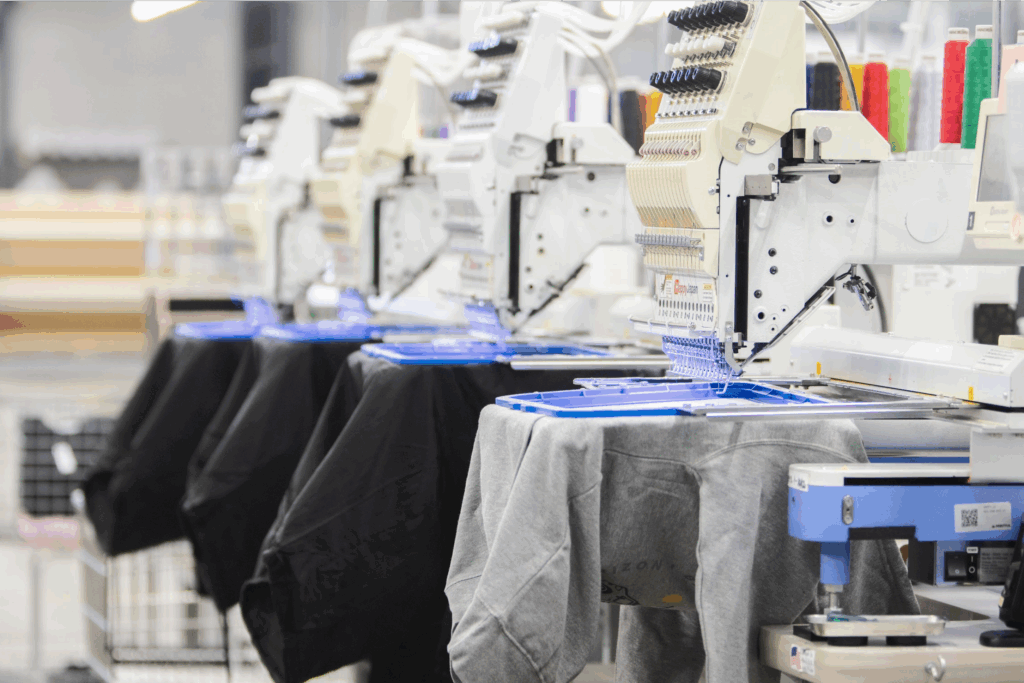Your business, your way – sell with Printify
As a print-on-demand (POD) seller, you’re likely aware of the ongoing discussions around China tariffs and how they’ll affect your margins.
But what exactly are tariffs, and how do they impact your business? More importantly, how can you navigate these challenges to maintain profitability and customer satisfaction?
We’ll walk you through what’s happening with China tariffs in 2025, how they affect global trade, and what practical steps you can take right now to adapt.
This content is for informational purposes only and does not constitute professional advice. The content is based on our understanding as of the date of publication. Readers are encouraged to seek advice from qualified professionals. Any actions taken based on this information are at your own risk.
Key takeaways
- In 2025, President Donald Trump reintroduced steep tariffs on Chinese goods.
- US tariffs on China peaked at 145%, prompting China’s retaliatory tariffs of up to 125% on American imports.
- A 90‑day agreement starting May 14 temporarily lowered many US tariffs on Chinese imports to 30% and Chinese tariffs on US goods to 10%, offering short‑term relief for sellers. This has since been extended into early November 2025, though some high tariffs and sector‑specific measures remain in force.
- Tariffs can have a negative impact on pricing, sourcing, shipping, and customer satisfaction, but print-on-demand sellers have the flexibility to adjust.
- Solutions like Printify Choice help merchants adapt by routing orders to the best local providers, protecting margins, and avoiding higher shipping costs.
What is a tariff, and how does it work?

A tariff is a tax imposed by a government on goods imported from another country. This makes foreign goods more expensive.
Tariffs can give domestic industries a better chance to compete, but they often lead to higher prices for consumers.
Types of tariffs
- Ad valorem tariffs: A percentage-based tariff. For example, a 10% tariff on a $100 product adds $10 to the cost.
- Specific tariffs: A fixed amount per unit – say, $5 per t-shirt, regardless of its price.
- Retaliatory tariffs: Tariffs a country imposes in direct response to tariffs placed on its goods by another country, sometimes resulting in a trade war.
How are tariffs imposed, and who pays them?
Tariffs are put in place by governments, usually through legislation or executive orders.
In the US, for example, the president or Congress may authorize tariffs on goods from specific countries or on particular product categories.
But who actually pays these tariffs? Technically, it’s the importer – the business or individual bringing the goods into the country. That fee is paid when the goods enter through customs.
However, the cost rarely stops there.
Most importers pass that extra cost down the supply chain. That means wholesalers, retailers, and ultimately consumers end up paying more.
So, even though the tariff is charged at the border, it often results in higher prices for everyday items, like clothing, electronics, or even print-on-demand products.
For businesses, this creates a chain reaction of increased costs, tougher pricing decisions, and more pressure to stay competitive. That’s why it’s important to monitor tariff policies and adapt quickly, especially in fast-moving industries like eCommerce.
The China tariffs 2025 landscape
As of 2025, trade between the largest economies in the world has been shaped by a series of significant tariff actions. These measures were introduced under the direction of President Trump in order to pursue trade realignment.
Here’s a quick timeline of the current tariffs between China and the US:
- February: President Donald Trump’s administration imposed a 10% tariff on Chinese imports – one of several unilateral tariff measures aimed at reducing the US trade deficit.
- March: Trump’s China tariffs rate jumped to 20%, and the de minimis exemption (which previously allowed duty-free treatment for imports under $800) was eliminated for Chinese goods.
- April: A 145% tariff was applied to many Chinese goods, combining multiple duties, including a 125% reciprocal tariff layered on top of previous rates. China’s response to Trump tariffs included a 125% tariff on US goods, targeting a wide range of American exports.
- May: Following trade talks in Switzerland conducted by US Treasury Secretary Scott Bessent, Trade Representative Jamieson Greer, and the Chinese Vice Premier He Lifeng, Washington and Beijing agreed to a 90-day tariff reduction starting Wednesday, May 14. Under this agreement, many US tariffs on Chinese imports were temporarily lowered to 30%, while Chinese tariffs on US goods dropped to 10%.
- The temporary truce, initially set for 90 days, has since been extended into early November 2025. However, some sector-specific tariffs and measures – such as IEEPA-related duties – remain.
- In addition to the tariff cuts, Chinese officials have also agreed to suspend certain non-tariff measures during this period, offering further potential relief for US exporters.
The temporary suspension is viewed as a first step toward negotiating a big trade deal, though discussions are still ongoing between the two countries.
Economic impact of China’s tariffs
China’s tariffs on the US and the reciprocal tariffs on Chinese goods ripple through the global economy, affecting businesses, investors, and everyday consumers.
For businesses and consumers
For consumers, it’s impacting price tags. When importers face steep tariffs, those costs usually get passed down the line. Shoppers end up paying more for basics like clothing and electronics without realizing that it’s due to tariffs.
Importers and businesses are adjusting their strategies. Many are now exploring alternative suppliers in countries with fewer trade barriers or shifting production closer to where customers are.
Financial markets tend to react quickly to trade policy changes, driven by shifting expectations around stability, inflation, and supply chain resilience. New tariffs, negotiations, or retaliatory moves between the US and China can lead to market volatility as investors reassess risk.
Shipping and logistics may face delays and congestion. With new compliance rules and unpredictable costs, shipping containers may sit longer at ports while customs sort through tariffed goods.
Government and institutions
The US central bank is keeping a close eye on inflation and rising prices. That affects decisions on interest rates, which in turn influence everything from credit card payments to business loans.
At a policy level, US officials acknowledge the weight of these disruptions.
While official statements are measured, the current direction from leaders like Treasury Secretary Scott Bessent and Trade Representative Jamieson Greer is focused on stabilizing trade flows.
Managing inflationary pressure and preserving US economic resilience while addressing concerns over China’s role in global manufacturing and trade are also top priorities.
Effects on print-on-demand businesses
For print-on-demand sellers, tariffs show up in a few key areas. While these won’t disrupt operations entirely, there are new variables to account for.
- Material costs can rise, especially for blanks and base products from countries like China. Apparel, mugs, phone cases, and other popular POD items may become more expensive to source.
- Fulfillment becomes more nuanced. Even if the final product is printed locally, tariffs may still apply if the blank item comes from a tariffed country. That’s why understanding your product’s entire supply chain matters more than ever.
- Shipping and delivery timelines can shift as customs processes adjust to new documentation and tariff rules. It’s not always a delay, but it’s another factor to account for.
- Margins may get smaller if costs rise and pricing strategies don’t adjust. But this is also an opportunity to use smarter tools and sourcing solutions, like domestic fulfillment options through Printify Choice.
While a lot of attention is on Chinese imports right now, this is part of a larger ecosystem. Other countries are also involved in trade negotiations and reciprocal tariffs, so it’s worth thinking globally and planning locally.
The good news? Print-on-demand is adaptable. You don’t hold inventory, you’re not locked in with one supplier, and you can shift strategies faster than traditional retailers. That flexibility is your superpower in moments like this.
Printify Choice: Your best defense against tariffs
While we can’t eliminate tariffs, we’ve built something that helps you ride out the storm.
Think of Printify Choice as your tariff shock absorber. It automatically routes your orders to the best possible Print Provider based on location, speed, cost, and quality.
This means:
- Global network, local fulfillment: We source, print, and ship worldwide from more than 125 fulfillment locations, including in the US, Canada, and the EU.
- Smart routing: You don’t have to manually choose suppliers. Our algorithm picks the best provider for every order, every time.
- Margin protection: By shifting fulfillment closer to your customer, you can minimize delivery costs and avoid getting hit with steep tariffs on cross-border shipments.
- No stress: Keep selling while we handle the logistics. Maximum profit, minimum anxiety.
Even as new tariffs roll in, Printify Choice helps you stay competitive by delivering flexibility, speed, and value where it matters most.
How to use Printify Choice
- Find Printify Choice products in our Catalog.

- Under Select a fulfillment option, click on Printify Choice network. Then, hit Start designing.

- Communicate with customers about where your products are being produced. Be transparent about potential shipping times and costs, especially if changes occur due to trade policies.
FAQ
In spring 2025, President Donald Trump’s administration set a combined tariff rate of up to 145% on many Chinese imports. This included pre-existing tariffs, a 20% IEEPA (fentanyl-related) tariff, and a 125% tariff introduced in April.
However, following trade talks in Switzerland, Washington and Beijing agreed to a 90-day mutual tariff reduction, effective May 14. During this period, most US tariffs on Chinese goods were lowered to 30%, and Chinese tariffs on US exports were reduced to 10%.
This temporary agreement has since been extended into early November 2025, although certain sector-specific tariffs remain in place.
It’s highly unlikely, but if it did happen, it would seriously impact worldwide trade. The global supply chain would face major disruptions and shortages.
Prices would skyrocket, and sourcing alternatives would be limited for many industries, including POD.
Yes. In response to the US-imposed import tax on Chinese goods, China applied retaliatory tariffs on US products.
As of May 2025, Donald Trump’s tariff on China has been temporarily reduced to 30%, while China’s tariff on US goods has been lowered to 10%. However, these may not apply to all products, depending on their classification.
To remain competitive in the market, it’s essential for businesses to stay alert to policy shifts surrounding current tariffs on China and global trade.
A tariff is an added tax on imported goods. The importer pays it, and in most cases, the cost is built into the final product price that customers see.
Conclusion
The current Trump tariffs on Chinese goods are affecting global trade, pricing, and how you sell – but they don’t have to derail your business.
At Printify, we’re adapting quickly to help our merchants stay profitable. Our team is watching these developments closely. With Printify Choice, you can stay agile, protect your margins, and keep selling wherever your customers are.
If you’re looking for a simple, smart way to handle tariffs and keep growing your store, now’s the time to switch to Printify Choice.
And remember, the situation is still evolving – staying informed and flexible is key.












